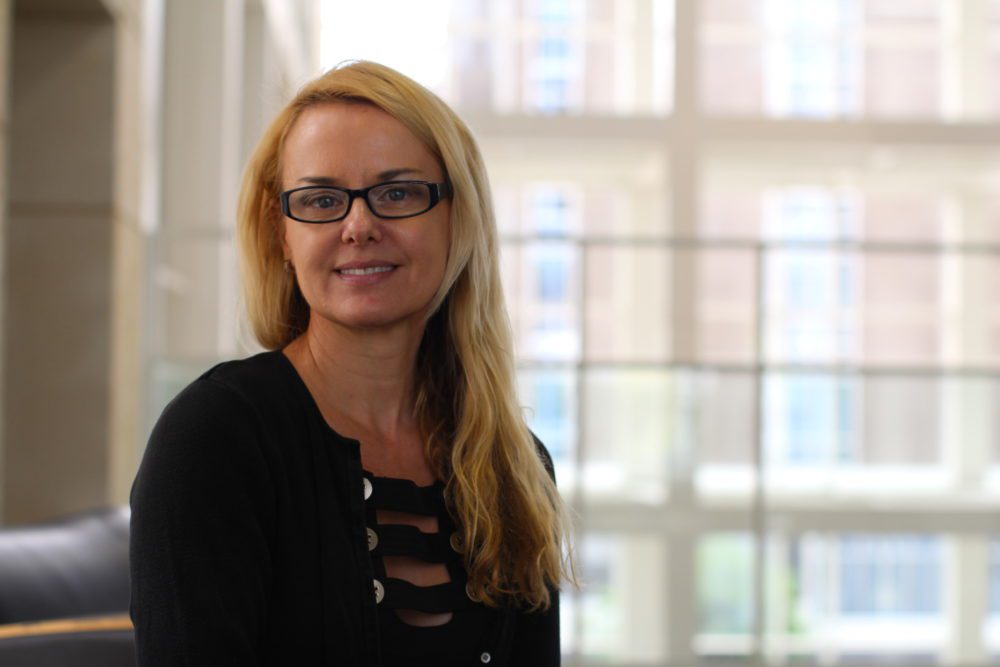Zora Carrier, Ph.D., is the executive director of the Florida Museum of Photographic Arts. Photo by David R. Wheeler.
By David R. Wheeler, Editor
“I think photography can teach us to slow down,” says Zora Carrier, executive director of the Florida Museum of Photographic Arts, the striking cube-shaped photography museum at the corner of Ashley and Kennedy in downtown Tampa. “If we pay attention to detail, we are better people. We’re more meaningful in our reactions. We’re suddenly sensitive to very subtle details.”
Zora and I are sitting in the impressive atrium of the “cube,” overlooking the lobby, as the afternoon light streams in from the gigantic circular windows that are part of the building’s trademark architecture.
She goes on, “I think this meaningful interaction with the image is something that actually makes us better, because then we’re more sensitive to subtle details when we’re outside of the museum.”
Carrier became director of FMoPA in 2013, and under her leadership, the museum is indeed helping Tampa Bay to slow down. Of course, the building itself causes people to slow down — quite literally, as they drive by and marvel at the unusual architecture. But Carrier is succeeding in getting people to slow down in other ways, too. Ultimately, Carrier believes, we can all become better people through the appreciation and practice of photography.
Under Carrier’s leadership, the museum has cultivated relationships with nationally acclaimed photographers, created a presentation room that can accommodate 100 people (compared to a previous space holding 20 or 30), and expanded its international photography competition, which received 880 submissions from four continents this year. The exhibition was held in June.
“The winner was from Iran, which has a very different view of photography,” Carrier says. “And it was a female photographer. So I’m very proud of that.”
Carrier’s career has been filled with joy and wonder — but also with multi-tasking. So it’s no surprise that she would emphasize the importance of slowing down.
Having grown up in Czechoslovakia before the Iron Curtain fell, Carrier earned a Ph.D. in education from Comenius University in Bratislava. Since then, she’s been able to weave together two of her passions — art and education.
It started when she was a child. “I think my interests and art and education were developing simultaneously, because my mom collected art and antiques,” Carrier says. “She wasn’t creating; she wasn’t handy. But she was appreciating and collecting. So that was always part of our life.”
Carrier says her artistic and educational passions merged later in life. “I saw that I can change the world by offering some education in art,” she says, admitting that “changing the world” is an idealistic notion.
In 2002, Carrier moved to Prague with her friend Olga, who also had a passion for contemporary art, and the two of them started a nonprofit art gallery. “We were very lucky to find a space in downtown Prague, a very prominent industrial place that was looking for a big investor who would renovate that space,” she says.
They made an agreement with the owner, and they used the space to open Gallery Art Factory, which showcased the work of local artists, most of whom were under 30 years old.
After serving as the director of the Prague museum, she moved to the U.S. and co-founded the Open Concept Gallery in Grand Rapids, Michigan, in 2006. “The Open Concept Gallery was a nonprofit gallery focusing on contemporary art, creating opportunities for up-and-coming artists, both local and nationally acclaimed.” The museum also launched public art projects, which Carrier calls “passion-driven.”
“It’s a huge production to put something in the public space,” she says. “And it’s a service to the community, and to art, and to art education. People who typically don’t go to museums or galleries are suddenly part of the public art project, and so I enjoyed that very much.”
There are similarities between her previous art administration jobs and her current one at FMoPA. The most obvious one would be the degree of multi-tasking required.
“All the management, marketing and leadership opportunities that you have in a small institution — you carry those with you,” she says. “We would do our own preparatory work, hold press conferences, and just do very diverse jobs at the same time.”
At FMoPA, in addition to doing the managing, fundraising, and marketing for the museum, Carrier still finds time to teach classes on art interpretation, and she even offers an occasional one-on-one photography course.
One aspect of life in Tampa Bay that Carrier especially loves is that it’s open to foreigners. “People here are so used to snowbirds and people in transition,” she says. “The diversity can’t compare to what’s going on in the Midwest.”
She sits back and smiles. “Tampa Bay was very welcoming. I loved it from the first day.”


